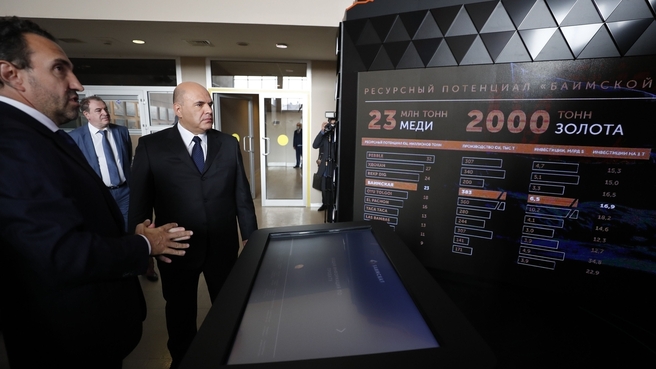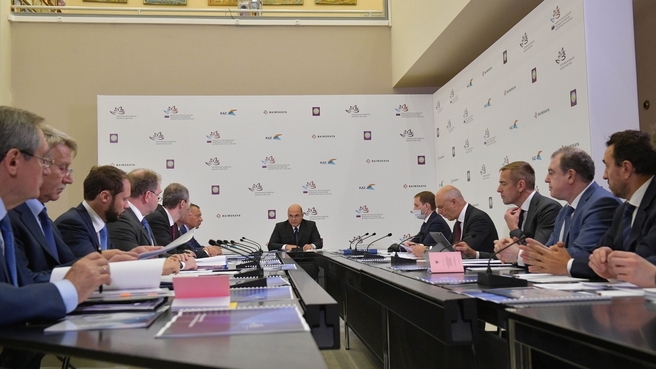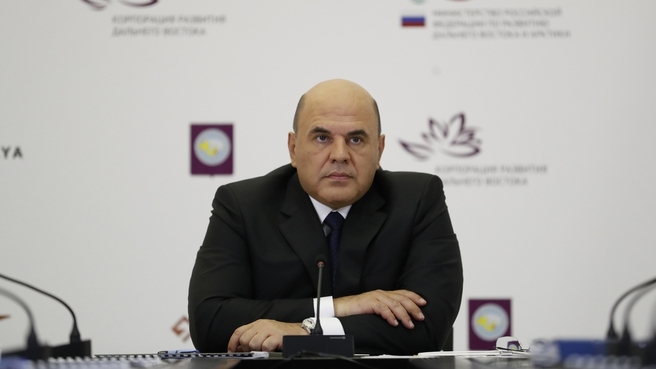Mikhail Mishustin: “The Baimskaya range ranks among the world’s five largest undeveloped sites with rich deposits of copper, as well as gold, silver and molybdenum. Developing this area will support the entire Chukotka Autonomous Area, and will have a positive effect on reaching our federal goals, including increasing cargo volume on the Northern Sea Route and developing the Arctic zone in general.”
Mikhail Mishustin toured a stand presenting the Baimsky Mining and Processing Complex prior to the meeting.
The investment project for 2019 ̶ 2026 provides for building a mining and processing complex with an annual output of 70 million tonnes of ore.
On-site construction has already started, while engineering studies and the design of support facilities (an airfield, storage for explosives, accommodation for construction workers) have been completed.
The investment project is expected to increase Russia’s output of non-ferrous metals with a 15 to 20 percent increase in copper concentrate, 3.7 percent in gold, 5 percent in silver and 77 percent in molybdenum. Cargo volume on the Northern Sea Route will increase by up to 2 million tonnes.
Mikhail Mishustin’s opening remarks:
Good afternoon, colleagues.
Today, we will discuss the investment project to develop the Baimskaya ore range. It ranks as the world’s fourth largest undeveloped mining site with rich deposits of copper, as well as gold, silver and molybdenum. Developing this area will support the entire Chukotka Autonomous Area, and will have a positive effect on reaching our federal goals, including increasing cargo volume on the Northern Sea Route and developing the Arctic zone in general.
A major private investor has expressed interest in developing these deposits: KAZ Minerals, a company from the Republic of Kazakhstan. The project provides for building a mining and processing centre with a capacity of up to 70 million tonnes of ore per year. This also includes creating more than 3,000 jobs, or even 3,500 as we heard today, and much more during construction. With this plant, Russia’s annual copper output is expected to increase by 15 or 20 percent, while molybdenum would surge by almost 80 percent.
State-of-the-art solutions will have to be used in this harsh climate. Today, we heard about autonomous dump-trucks. There will be more than 70 vehicles of this kind. All production processes will be automated as much as possible. If successful, this experience will be used when developing other deposits in challenging environments. It is essential that any construction project, especially major undertakings like this one, comply with environment protection standards, as well as health regulations. The government will have to support this project financially to get it off the ground. In particular, this relates to finding resources for creating energy and transport infrastructure. There are different opinions and various options here. As we have heard today, one of the main proposals is to build an LNG power plant at the seaport and a 430 kilometre haul road.
Today, I suggest we discuss the possible options in order to understand what approach will be chosen and what kind of government support will be needed. There is also the question of the short- and medium-term return from this project for the region, for businesses and for Russia in general.








